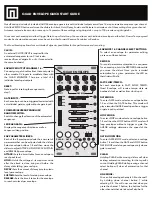
2-5
IM 2560A-01EN
Features
3
2
1
4
5
6
7
8
9
10
11
12
13
14
15
16
App
Index
• Manual input
The 2560A sources thermoelectromotive force that is corrected using the manually input
temperature.
If you do not want to apply correction (not use the RJC function), you set the temperature to 0°C.
* In a thermocouple temperature measurement, the temperature is measured from the thermoelectromotive
force that is produced due to the temperature difference between the measurement point and the
other contact point. If the other contact point is 0°C, the temperature at the measurement point can be
found straight from the thermoelectromotive force. Normally, the other contact point is a terminal on a
measuring instrument, so the temperature of that terminal is measured and used for correcting the actual
measurement. This is called reference junction compensation.
RTD
The 2560A outputs from its low voltage-current output terminals (OUTPUT 1) the resistance of an RTD
Pt100 that corresponds to the specified temperature. The 2560A supports Pt100, which is defined
by IEC and JIS standards. It is also possible to user-define the relationship between temperature and
resistance and output resistance according to the definition.
Type
Source Range
Pt100
-200.0°C to +850.0°C
RTD USER
(user-defined)
-9999.9°C to +9999.9°C
But, a temperature range
corresponding to the resistance
source range (1.00 Ω to 400.00 Ω)
Temperature Unit
If the suffix code is -UC, the temperature unit is Celsius (°C). If the suffix code is -UF, you can select
Celsius (°C) or Fahrenheit (°F). You use the SETUP menu to select it.
Turning the Output On and Off
The output of a thermoelectromotive force or resistance that corresponds to the specified temperature
can be turned on and off.
• ON
Thermoelectromotive force or resistance is output from the low voltage-current output terminals
(OUTPUT 1). If the main setting display is blinking, the output cannot be turned on.
• OFF
No output is produced. If you change the thermocouple or RTD type, the output automatically turns
off.
Output Value
The output value of the 2560A is calculated from the scale, output divider, and deviation settings
(explained later) within the thermoelectromotive force or resistance source range explained in this
section. The relational expression is shown below.
Output value = MIN + (MAX − MIN)×(n/m) + (MAX − MIN)×(−deviation)
MAX:
Maximum value of the scale (output range) (see
section 2.4)
MIN:
Minimum value of the scale (output range) (see
section 2.4)
m:
Denominator of the output divider (see section 2.5)
n:
Numerator of the output divider (see section 2.5)
Deviation: See section 2.6.
2.3 Temperature-Sensor-Simulation Thermoelectromotive-Force and Resistance Sourcing
















































